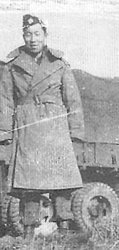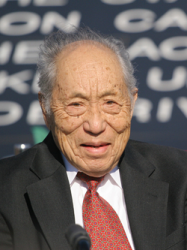
 |
|
|
||
|
Young Oak Kim |
||||
|
Engagements: • World War II (1941 - 1945)• Korean War (1950 - 1953) |
||||
| Biography: | ||||
|
Young Oak Kim Young Oak Kim was born on 29 January 1919 in Los Angeles, CA, to Soon Kwon Kim and Nora Koh Kim. He had three brothers, two sisters, and one adopted brother, Andy Kil. His father was a member of Daehanin-dongjihwe literally: "The Great Korean Association"), the group Syngman Rhee established in Hawaii to help liberate Korea from Japan. This background helped Kim build a strong cultural identity. He grew up in Bunker Hill, Los Angeles, CA, where his father operated a grocery store at the intersection of Temple Street and Figueroa Street. Kim graduated from Belmont High School and attended Los Angeles City College. He dropped out after a year. He tried various jobs, but racial discrimination prevented him from staying long at any job. The U.S. Army refused his enlistment for the same reason. But after the U.S. Congress enacted a law subjecting Asian Americans to conscription, Kim was drafted into the Army. He entered military service on 31 January 1941, three months before his father died. World War II After spending six months in the Army as an Engineer, Kim was selected for the Infantry Officer Candidate School at Fort Benning, GA. Upon graduating in January 1943, he was assigned to the U.S. 100th Infantry Battalion, a Unit of Japanese Americans from Hawaii. The Battalion Commander offered him a transfer, fearing ethnic conflict. (Korea was still under Japanese control.) But he insisted on staying, saying "There is no Japanese nor Korean here. We're all Americans and we're fighting for the same cause." The 100th Battalion was sent to North Africa to assist in the war in Europe, but initially the U.S. Army had no plan for its deployment. By its own request, the Battalion was sent to the front and joined the war in Italy. There, Kim's map-reading skills and determination led to success in many battles and some "impossible missions." In November 1943, Second Lieutenant Young Oak Kim was serving with Company B, 100th Infantry Battalion (Separate), attached to the 34th Infantry Division, Fifth U.S. Army. During that month, his unit was in action against the Germans in Italy. 2LT Kim was 1 of 3 men acting as scouts for his combat patrol with the mission of clearing an area known to contain German machine-gun positions. Advancing ahead of the patrol, the scouts discovered a German ammunition-carrying party and 2LT Kim intentionally drew the enemy fire so that the other 2 men could locate and dispose of the enemy with hand grenades. By repeating these tactics, 2LT Kim and his comrades accounted for destroying 4 enemy machine-gun nests and captured 7 German prisoners. Later that month, 2LT Kim observed an entire German company entering the area and although his patrol was outnumbered, he held his ground, ordering his men to hold their fire until an enemy platoon had entered the area. They then opened fire and the trapped Germans fled in disorder, but 2LT Kim and his men flanked them and drove them into adjacent friendly troops. As a result, the entire German platoon was either killed or captured. 2LT Kim's outstanding leadership, courageous actions and extraordinary heroism that day earned him the U.S. Army's third highest award for valor, the Silver Star Medal. In the planning for Operation Diadem, the Allies needed to determine the locations of German tank units. On 16 May 1944, then-First Lieutenant Kim was serving with Headquarters Company, 100th Infantry Battalion (Separate), attached to the 34th Infantry Division, Fifth U.S. Army. On that day, 1LT Kims’ unit was in action against German forces near Cisterna, Italy. 1LT Kim, accompanied by one enlisted man, Private First Class Irving Akahoshi, went on a patrol to secure information about German units and positions in a vital sector of the front, although previous patrols of combat strength had tried, without success, to take prisoners in this well-defended sector. 1LT Kim and PFC Akahoshi infiltrated approximately 800 yards through the enemy's line of outposts. While observing German positions, he discovered a strong enemy outpost situated in a small ditch. To reach this outpost, 1LT Kim and PFC Akahoshi, in broad daylight, crawled 250 yards across an open field, exposed to enemy observation from the German main line of resistance on the commanding slope to their rear. Arriving at a point near the outpost, they surprised 2 Germans armed with machine pistols who were acting as security. By use of signs, 1LT Kim warned the enemy to remain quiet. He retraced his perilous route with the 2 prisoners and successfully by-passed 2 enemy listening posts to arrive back at his own lines. 1LT Kims’ bold, courageous actions and extraordinary heroism that day earned him the U.S. Army's second highest award for valor, the Distinguished Service Cross. The information that Allied Intelligence gathered from interrogating the two German prisoners captured by 1LT Kim and PFC Akahoshi helped determine that there was not a tank unit in the breakthrough path the Allies were considering. The Allies then broke the Gustav Line, and liberated Rome.Kim also led elements of the 100th Battalion in battles at Belvedere and Pisa, which helped break the Gothic Line. The Allies were able to occupy Pisa without casualties. In France, Kim was the Battalion's Operations Officer. He fought in battles that liberated the towns of Bruyères and Biffontaine. He sustained severe wounds from enemy fire in Biffontaine, and later spent a 6-month leave in Los Angeles in late 1944. Germany surrendered shortly before he was to return to the European Theater of Operations. Korean War Kim left the Army after World War II. However, there were not many opportunities for a young Korean man. He started a self-service laundry, which was quite rare at the time. The business was very successful; Kim's earnings were five times his salary as an Army Captain. Two years later, war broke out in Korea. Kim abandoned the business and re-entered the Army: "As a Korean, the most direct way to help my father's country even a little, and as a U.S. citizen, the most direct way to repay even a little the debt owed to Korea by the U.S. was to go to Korea, pick up a gun and fight." Young-Oak Kim, interview, The Chosun Ilbo The Army allowed all soldiers with Korean heritage-and anyone who could speak at least a word of Korean-to work in the Army Security Agency. Kim was no exception, but he wanted to fight. At his request, he was sent to East Asia, and by pretending not to know any Korean and with the help of people he had known from World War II, he was able to join the Infantry. This was the first time he had ever been to Korea. He was assigned to the 31st Infantry of the 7th Infantry Division in April 1951 as the Intelligence Officer, under William J. McCaffrey, who scouted him. Kim worked not only as an Intelligence Officer, but also virtually as an Operations Officer, by the request of McCaffrey. Kim rescued many U.S. and Korean Army troops in several battles. The 31st Infantry played a major role in stopping Chinese troops, and pushing them back above the 38th parallel. Kim's unit was the very first to cross that line. The 7th Infantry Division redrew the situation map every day, but only recorded the locations regiments or larger military units. However, the map from 31 May 1951 included the location of Kim's Battalion. During Operation Piledriver in August, after a battle in which his unit proceeded to the north of Kimhwa, his unit was mistakenly bombarded by the 555th Field Artillery Battalion, because it seemed too far north to be friendly. Kim was seriously injured in the friendly fire incident. He was saved by doctors from Johns Hopkins University, who were in Tokyo. He made it back to Korea after two months of recuperation. Upon his return, McCaffrey put him in command of the Regiment's 1st Battalion. After fighting for nearly a year, Kim left Korea in September 1952. Kim also organized his unit's sponsorship of an orphanage in Seoul. In 2003, the government of the Republic of Korea decorated Kim for his social service. Kim returned to Korea in the 1960s as a U.S. military advisor. After serving in the Army for 30 years, Kim retired in 1972. In Retirement After retiring, Kim actively participated in Asian-American community affairs. He helped found the Go For Broke Monument, Go For Broke Educational Foundation, the Japanese American National Museum, the Korean Health, Education, Information and Research Center, the Korean American Coalition, the Korean American Museum, the Korean Youth and Cultural Center, and the Center for Pacific Asian Families. Medals, Awards and Badges Distinguished Service CrossSilver Star Medal with Bronze Oak Leaf Cluster Bronze Star Medal (Merit) with Bronze Oak Leaf Cluster Purple Heart with 2 Bronze Oak Leaf Clusters American Campaign Medal European-African-Middle Eastern Campaign Medal with Arrowhead Pin and 4 Bronze Stars World War II Victory Medal National Defense Service Medal Korean Service Medal with 2 Bronze Stars United Nations Service Medal Republic of Korea War Service Medal Presidential Unit Citation with 3 Bronze Oak Leaf Clusters Republic of Korea Presidential Unit Citation Medal Combat Infantryman Badge with Star (Second Award) Foreign Medals and Awards Officer of the National Order of the Legion of Honor (France)Légion d'honneur (France) Croix de guerre (France) Military Valor Cross (Italy) Taeguk Cordon of the Order of Military Merit (Posthumous Award from South Korea) Distinguished Service Cross Citation The President of the United States of America, authorized by Act of Congress, July 9, 1918, takes pleasure in presenting the Distinguished Service Cross to First Lieutenant (Infantry) Young Oak Kim (ASN: 0-1309572), United States Army, for extraordinary heroism in connection with military operations against an armed enemy while serving Headquarters Company, 100th Infantry Battalion (Separate), attached to the 34th Infantry Division, in action against enemy forces near Cisterna, Italy, on 16 May 1944. First Lieutenant Kim, accompanied by one enlisted man, voluntarily went on a patrol to secure information of enemy units and dispositions in a vital sector of the front. All previous patrols of combat strength had attempted without success to take prisoners in this well defended sector. First Lieutenant Kim and his assistant infiltrated approximately 800 yards through the enemy line of outposts. While observing enemy dispositions, he discovered a strong enemy outpost situated in a small ditch. To reach this outpost, First Lieutenant Kim and his assistant, in broad daylight, crawled 250 yards across an open field, exposed to enemy observation from the German main line of resistance on the commanding slope of their rear. Arriving at a point near the outpost, they surprised two Germans armed with machine pistols who were acting as security. By use of signs, First Lieutenant Kim warned the enemy to remain quiet. He retraced his perilous route with the two prisoners and successfully by-passed two enemy listening posts to arrive at his own lines. First Lieutenant Kim's courageous and daring performance provided vital information and identification of enemy units in a critical sector of the front. General Orders: Headquarters, Fifth U.S. Army, General Orders No. 102 (June 18, 1944) Honors A newly-opened middle school in Los Angeles' fourth local district was named Young Oak Kim Academy in 2009 in recognition of Kim. Death and Burial Colonel Young Oak Kim died of cancer on 29 December 2005 at Cedars-Sinai Medical Center in Los Angeles, CA. He was 86. He is buried at the National Memorial Cemetery of the Pacific in Honolulu, HI. He was survived by three stepsons, as well as one sister and two brothers. |
||||
| Honoree ID: 2706 | Created by: MHOH | |||
Ribbons
Medals
Badges
Honoree Photos
 |  |  |
 |  |
 |


